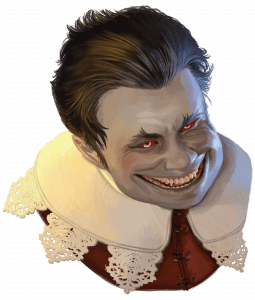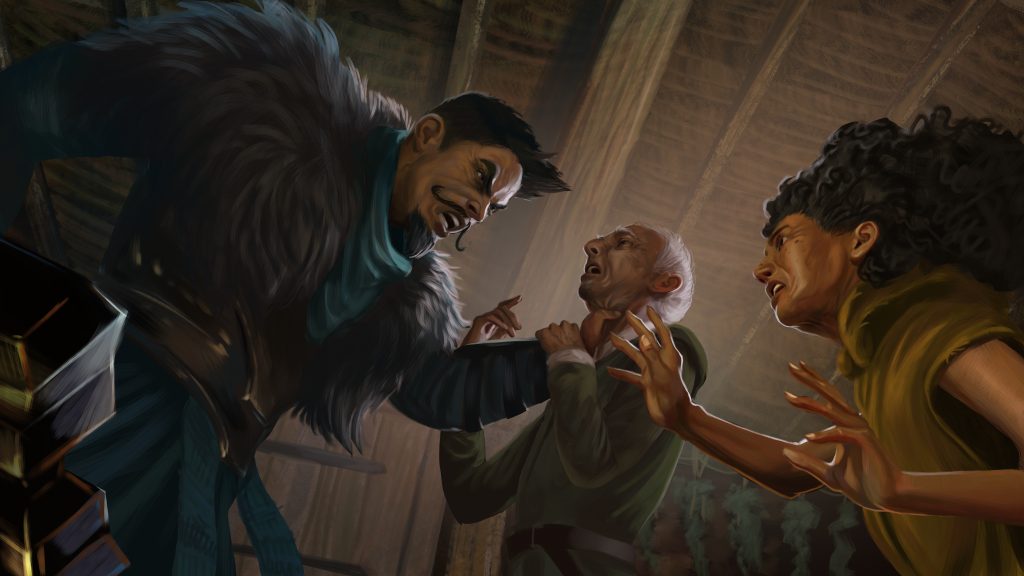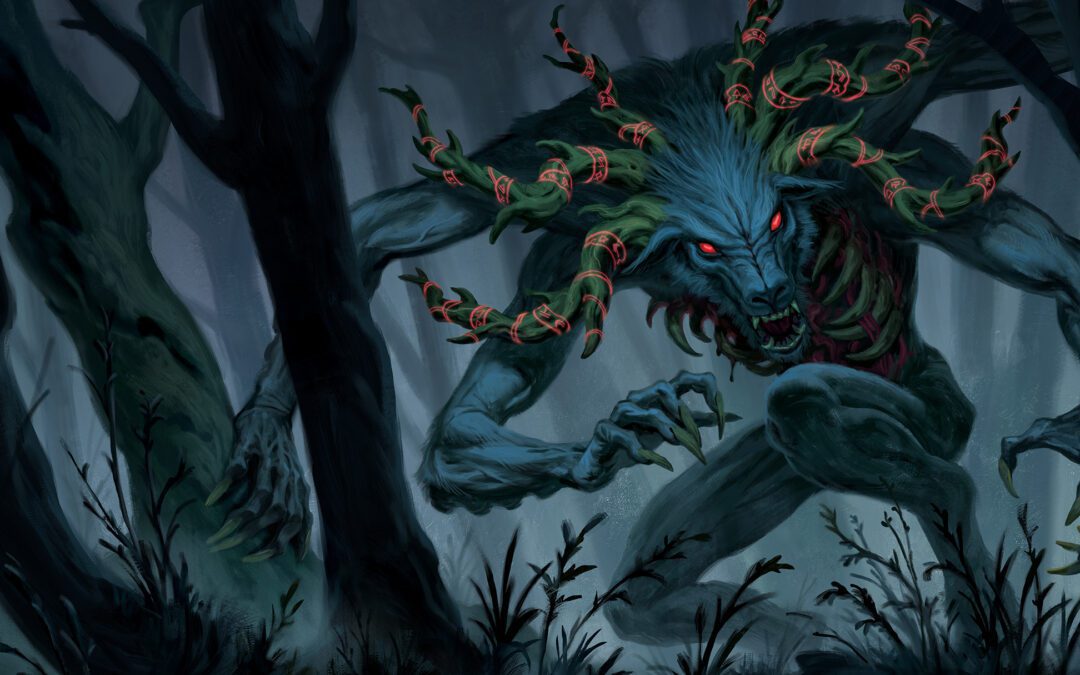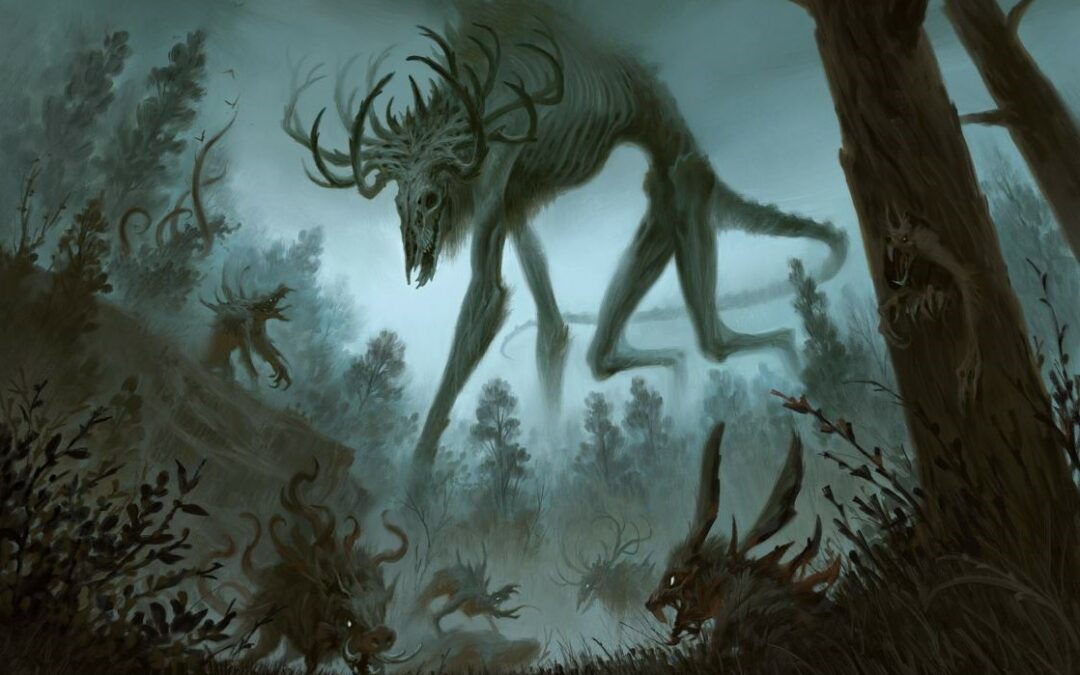
Welcome back to this veritably villainous blog series! Over the course of five articles, we’ll be chatting about the need-to-knows of building and running evil campaigns for the 5th Edition! So, sharpen your soul stealing blades and don your spiked armor, because we’re in for a wicked ride.
Why are villains so important?

Artist: Suzanne Helmigh
In most stories, you can count on the appearance of two things: protagonists and antagonists. In 5th Edition, your player characters are obviously the protagonists (yes, even in evil campaigns), but let’s pause and chat about the role of antagonists in campaigns. Antagonists don’t necessarily have to be a person. A narrative antagonist can be the self, society, nature, machine, or fate itself. However, when it comes to TTRPG’s, the most successful antagonists are the ones with a face. It’s all well and good to say your campaign is about overthrowing oppression, but if you don’t have a central figure who represents that oppression, your players will never quite know how to solve the problem. Similarly, while Robin Hood can’t singlehandedly end the economic brutalism of his era, it sure does feel like a victory when the Sheriff of Nottingham gets thrown in jail. This example shows why villains are so important in your stories. They are the defeat-able embodiments of concepts we may never be able to conquer truly.
Villains in Evil Campaigns
You might be wondering if it is accurate to call the antagonist of an evil campaign a villain. The short answer is: yes. As the GM, you must root for your players every step of the way, whether their goal is saving the land or destroying it. Whatever the motivation, a GM must view their players as the heroes of the story and meddlesome NPCs who get in their way as the villains. Framing your stories in this way helps you objectively unfold the narrative of a campaign, regardless of what kind of characters you have. There are a few different types of villains that shine in evil campaigns, so let’s present a few and talk about what makes them so successful:
Knight in Shining Armor
The knight is a villain that all evil characters love to hate. While they aren’t necessarily a knight, they are a righteous champion committed to doing the right thing. The worst thing about these villains (in the eyes of an evil party anyway) is that they are genuinely good people, fighting with right on their side. Despite their good intentions, knights should never be naïve, or they will fail to be an interesting adversary. A knight as a villain knows the world is flawed, and their vision might be impossible, but they fight for it anyway because they must. That level of commitment is dangerous for any evil characters that happen to get in the way.
Knights work very well as low-level villains. Parties still in tier 1 or tier 2 level of play don’t have as many options for outrunning a righteous champion looking to dole out justice.
Examples. Judhakate, Javert in Les Misérables, The Brotherhood of Steel in Fallout 4
Puppet Master

Artist: Marius Bota
The puppet master is a villain you don’t expect until it’s too late. Often, this villain is mistakenly believed to be an ally or even an employer until their goal is achieved. The puppet master gives an evil party a taste of their own medicine by using them to achieve the puppet master’s agenda, then turning on them when they are most vulnerable. The puppet master villain can be used to great effect if done well, but the challenge is getting your party to trust them in the first place.
Puppet masters work well as mid-level tier or upper-level tier villains. Puppet masters are most effective as villains when they have had a significant amount of time with the party and have established a foundation of trust.
Examples. Idmon, The Initiative in Buffy the Vampire Slayer, Saruman in Lord of the Rings
Zealot
The zealot is similar to the knight insomuch as they relentlessly pursue a single goal with frightening tenacity. The zealot’s motivations, however, are what makes them a unique kind of villain. The zealot’s single-minded faith in their goal propels them towards incredible ruin for the sake of ruin itself, and they are often willing to sacrifice themselves in the process to make it happen. A zealot’s motivations might even be the same as an evil character’s, but the degree to which they take things is rarely in the best interests of any creature, evil or good.
Zealots can be easily scaled to be great villains for any level of play. Simply adjust their end goal as needed to scale with your adventurers. A low-level goal might be on a local scale, whereas a high-level goal might be global.
Examples. Countess Renata Dolorez, Vlad Dracula in Castlevania, The Joker in Batman
Corrupted

Artist: Andreia Ugrai
The corrupted is a villain who started as a bystander, acquaintance, or ally before circumstances radically changed them in some way. Corrupted villains are fascinating because their appearance is often the direct result of the party’s actions. Watching an evil party contend with a monster of their own creation: the villager they tormented, the priest they allowed to get possessed, the paladin they cast into a pit of undead, is always interesting.
Corrupted villains work well at any level of play, but they should rarely be the first villain a party encounters. Corrupted villains work best when they are least expected. They make fantastic secondary villains to raise the stakes while the characters might already be struggling with a primary villain.
Examples. Imhotep in The Mummy, Vanya Hargreeves in The Umbrella Academy
Outsider
The outsider is a villain whose motivations are so far from the realm of normalcy that their actions don’t play by the normal rules of morality. Outsider villains are beyond good and evil due to their very nature. Typically, outsiders pose equal threats to good and evil characters alike, and an evil party might find themselves forced to team up with good allies to bring down such an alien villain.
Outsider villains work best as upper-level tier villains. Your characters should feel well-established, familiar, and confident in their world before you introduce an outsider who breaks all the rules. The initial appearance of an outsider villain often coincides with an impending apocalypse, stoppable only by the most potent of adventurers.
Examples. Cthulhu in Call of Cthulhu, The Borg in Star Trek Next Generation
Qualities of an Excellent Villain
Many of the principles of building excellent villains generally apply to building excellent NPCs, with a few additional measures. When designing an interesting and challenging villain for your evil campaigns, keep the following rules in mind:
1. Adaptable – Player characters (especially in evil campaigns) grow and change greatly throughout a campaign. Your NPC’s should also grow and change. As events unfold, stakes rise, and mistakes are made, your villain needs to adapt. As the party levels up and gains access to more power, so should your villains. A villain who grows alongside a party feels like a real part of the world instead of a run-of-the-mill monster to slay.
2. Motivated – All memorable NPCs have one thing in common: they know their motivation. When you design a villain, you must figure out what they want and what their goals are. Having clear goals in mind will allow you to make bold and informed choices from moment to moment, giving life and credibility to your villain (or any NPC).
3. Resourceful – It is difficult for an enemy creature to stay alive in 5th Edition. The power deck is dramatically stacked in favor of the player characters. A direct one-on-one confrontation between your villain and the party will inevitably result in your villain’s defeat. You must keep this power dynamic in mind when plotting your villain’s next move. A villain must have the resources to interfere with a party and further their own goals without physically doing it all themselves. Having access to resources could mean an array of different things. Having access to henchmen, superior magic, transportation, advanced technology, political influence, or wealth are some ways your villain can maintain the upper edge against a powerful group of player characters.
4. Relatable – The most compelling villains of all are the ones we understand (at least a little). It is easy to see why a rampaging maniac has to be stopped, but it is much harder to face down a villain you connect with. Understanding the reasons behind why a villain does what they do elevates them in the eyes of your characters. It makes the matter more personal. In evil campaigns, you get to play with this relatability to the extreme. Your characters are already primed to think in extremes, so they can relate to the actions of your villains better than good characters ever could. Your villain’s actions and motivations should not be random. They should be reasonable from a certain (usually extreme) point of view.
5. Strategic – Due to the power imbalance inherent in 5th Edition, only the cleverest of villains stand a chance of survival. Only the foes who stick around through multiple sessions, arcs, or for an entire campaign are truly worthy of the title of villain, so they have to play their cards carefully. Strategic villains rarely reveal their plans from the beginning. They use misdirection to throw heroes off their trail and do whatever is necessary to maintain the upper hand.

Artist: Suzanne Helmigh
Ready-Made Villains
If you have a copy of Grim Hollow: The Campaign Guide, you already have a treasure trove of NPCs ripe for converting into villains! “Chapter 7: The Realms of Etharis” has sections detailing notable individuals for each region. Campaign guides and published adventures often have detailed NPCs with a wealth of mechanics, resources, and story hooks already created. If you don’t want to make a villain from scratch, just grab one of these NPCs and brainstorm a villainous scheme that will catch your players’ attention.
Capable villains are some of the strongest tools available to a GM running an evil campaign. By their very nature, villains can drive the plot, personally challenge your player characters, and mold the shape of your world. If you follow the guidelines presented here, you’ll have powerful agents to challenge your players no matter how tough they are.

![Grim Hollow: The Player's Guide [PDF]](https://b2358178.smushcdn.com/2358178/wp-content/uploads/2021/02/Grim-Hollow-players-Guide-PDF-600x600.jpg?lossy=1&strip=1&webp=1)


0 Comments